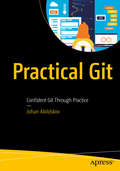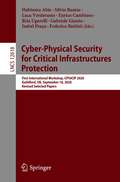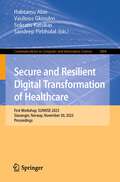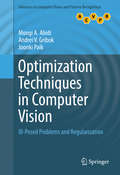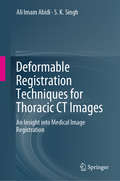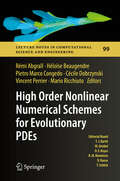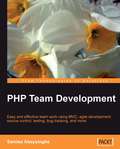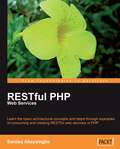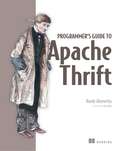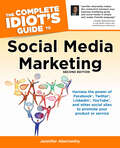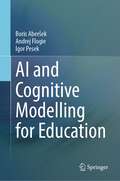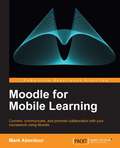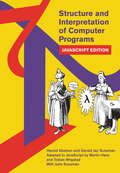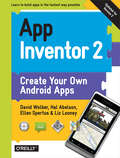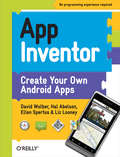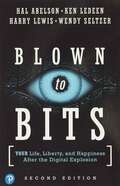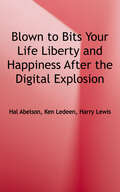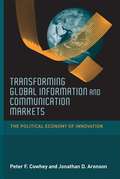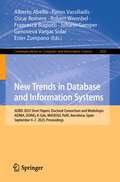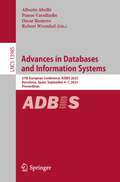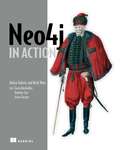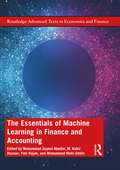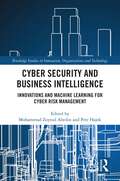- Table View
- List View
Liblouis User's and Programmer's Manual
by AbilitiessoftA guide for users and programmers on Liblouis, an open-source braille translator and back-translator.
Practical Git: Confident Git Through Practice
by Johan AbildskovPractice your Git skills using exercises in your own environment. This book introduces concepts in an abstract visual way, and then enforces this learning through exercises - the Git katas. You will start with basic interactions such as commits and branches, and move on to both internals and collaborative workflows. Best practices are introduced and rehearsed throughout with hands-on exercises. Each topic is supplemented with interactive Git exercises that can be solved using any Git client – either the ubiquituous CLI or one of the many graphical clients so you'll learn in the environment you work in. The importance of Git is hard to overstate – it is used by 90% of software engineers worldwide and is the de facto standard for version control. Honing your Git skills is guaranteed to make you a better and more efficient developer. Building software can be stressful, but it doesn’t need to be. Practical Git will give you the Git skills you need, and help keep your Git skills sharp. Add it to your library today. What You'll LearnUse Git through scripted exercises and the Git katas Understand Git’s graph modelTroubleshoot common and rare scenarios you may faceSelect and apply the right Git tool for the taskMaintain and collaborate on Git repositoriesTweak Git to gain the most from this powerful tool Who This Book Is For Anyone who is currently using Git in a copy-paste fashion. It will take you from using Git to knowing Git.
Cyber-Physical Security for Critical Infrastructures Protection: First International Workshop, CPS4CIP 2020, Guildford, UK, September 18, 2020, Revised Selected Papers (Lecture Notes in Computer Science #12618)
by Habtamu Abie Silvio Ranise Luca Verderame Enrico Cambiaso Rita Ugarelli Gabriele Giunta Isabel Praça Federica BattistiThis book constitutes the refereed proceedings of the First International Workshop on Cyber-Physical Security for Critical Infrastructures Protection, CPS4CIP 2020, which was organized in conjunction with the European Symposium on Research in Computer Security, ESORICS 2020, and held online on September 2020.The 14 full papers presented in this volume were carefully reviewed and selected from 24 submissions. They were organized in topical sections named: security threat intelligence; data anomaly detection: predict and prevent; computer vision and dataset for security; security management and governance; and impact propagation and power traffic analysis.The book contains 6 chapters which are available open access under a CC-BY license.
Secure and Resilient Digital Transformation of Healthcare: First Workshop, SUNRISE 2023, Stavanger, Norway, November 30, 2023, Proceedings (Communications in Computer and Information Science #1884)
by Habtamu Abie Vasileios Gkioulos Sokratis Katsikas Sandeep PirbhulalThis CCIS post conference volume constitutes the proceedings of First Workshop, SUNRISE 2023, in Stavanger, Norway, in November 2023. The 4 full papers together in this volume were carefully reviewed and selected from 9 submissions. The workshop offers a wide range of techniques addressing cybersecurity skills, access control, privacy risks, and resilience in healthcare systems.
Optimization Techniques in Computer Vision
by Mongi A. Abidi Andrei V. Gribok Joonki PaikThis book presents practical optimization techniques used in image processing and computer vision problems. Ill-posed problems are introduced and used as examples to show how each type of problem is related to typical image processing and computer vision problems. Unconstrained optimization gives the best solution based on numerical minimization of a single, scalar-valued objective function or cost function. Unconstrained optimization problems have been intensively studied, and many algorithms and tools have been developed to solve them. Most practical optimization problems, however, arise with a set of constraints. Typical examples of constraints include: (i) pre-specified pixel intensity range, (ii) smoothness or correlation with neighboring information, (iii) existence on a certain contour of lines or curves, and (iv) given statistical or spectral characteristics of the solution. Regularized optimization is a special method used to solve a class of constrained optimization problems. The term regularization refers to the transformation of an objective function with constraints into a different objective function, automatically reflecting constraints in the unconstrained minimization process. Because of its simplicity and efficiency, regularized optimization has many application areas, such as image restoration, image reconstruction, optical flow estimation, etc. Optimization plays a major role in a wide variety of theories for image processing and computer vision. Various optimization techniques are used at different levels for these problems, and this volume summarizes and explains these techniques as applied to image processing and computer vision.
Deformable Registration Techniques for Thoracic CT Images: An Insight into Medical Image Registration
by Ali Imam Abidi S.K. SinghThis book focuses on novel approaches for thoracic computed tomography (CT) image registration and determination of respiratory motion models in a range of patient scenarios. It discusses the use of image registration processes to remove the inconsistencies between medical images acquired using different devices. In the context of comparative research and medical analysis, these methods are of immense value in image registration procedures, not just for thoracic CT images, but for all types of medical images in multiple modalities, and also in establishing a mean respiration motion model. Combined with advanced techniques, the methods proposed have the potential to advance the field of computer vision and help improve existing methods. The book is a valuable resource for those in the scientific community involved in modeling respiratory motion for a large number of people.
High Order Nonlinear Numerical Schemes for Evolutionary PDEs
by Rémi Abgrall Héloïse Beaugendre Pietro Marco Congedo Cécile Dobrzynski Vincent Perrier Mario RicchiutoThis book collects papers presented during the European Workshop on High Order Nonlinear Numerical Methods for Evolutionary PDEs (HONOM 2013) that was held at INRIA Bordeaux Sud-Ouest, Talence, France in March, 2013. The central topic is high order methods for compressible fluid dynamics. In the workshop, and in this proceedings, greater emphasis is placed on the numerical than the theoretical aspects of this scientific field. The range of topics is broad, extending through algorithm design, accuracy, large scale computing, complex geometries, discontinuous Galerkin, finite element methods, Lagrangian hydrodynamics, finite difference methods and applications and uncertainty quantification. These techniques find practical applications in such fields as fluid mechanics, magnetohydrodynamics, nonlinear solid mechanics, and others for which genuinely nonlinear methods are needed.
PHP Team Development
by Samisa AbeysingheThis book looks into PHP projects mainly from an enterprise view. The author's experience enables him to give you an overall picture of PHP projects and discuss factors that contribute to project success in a clear and precise manner. Each chapter focuses specifically on how the techniques covered will make team work easier. Examples (rather than abstract best practices) are used to illustrate the practical benefits. This book is for PHP developers who work in teams on complex PHP projects. With this book in hand, it is easy to discover the secrets of successful PHP projects that meet today's complex enterprise demands. This book can also be useful for project managers who are looking to be successful with PHP projects. Those who are stakeholders in PHP projects, such as clients, or those who want to sponsor PHP projects, can also learn what to expect and how to deal with a PHP project team with this book.
RESTful PHP Web Services
by Samisa AbeysingheThe book explains the basic concepts associated with the REST architectural style, but the emphasis is on creating PHP code for consuming and creating RESTful services in PHP. There is plenty of example PHP code to illustrate the concepts, with careful explanations of how the code works. This book targets PHP developers who want to build or make use of RESTful web services, or explore the options available to them in PHP. You will need to know the basics of PHP development, but no knowledge of REST is assumed, nor any knowledge of creating web services generally.
Programmer's Guide to Apache Thrift
by William AbernethySummaryProgrammer's Guide to Apache Thrift provides comprehensive coverage of the Apache Thrift framework along with a developer's-eye view of modern distributed application architecture.Foreword by Jens Geyer.Purchase of the print book includes a free eBook in PDF, Kindle, and ePub formats from Manning Publications.About the TechnologyThrift-based distributed software systems are built out of communicating components that use different languages, protocols, and message types. Sitting between them is Thrift, which handles data serialization, transport, and service implementation. Thrift supports many client and server environments and a host of languages ranging from PHP to JavaScript, and from C++ to Go.About the BookProgrammer's Guide to Apache Thrift provides comprehensive coverage of distributed application communication using the Thrift framework. Packed with code examples and useful insight, this book presents best practices for multi-language distributed development. You'll take a guided tour through transports, protocols, IDL, and servers as you explore programs in C++, Java, and Python. You'll also learn how to work with platforms ranging from browser-based clients to enterprise servers. What's insideComplete coverage of Thrift's IDLBuilding and serializing complex user-defined typesPlug-in protocols, transports, and data compressionCreating cross-language services with RPC and messaging systemsAbout the ReaderReaders should be comfortable with a language like Python, Java, or C++ and the basics of service-oriented or microservice architectures.About the AuthorRandy Abernethy is an Apache Thrift Project Management Committee member and a partner at RX-M.Table of ContentsPART 1 - APACHE THRIFT OVERVIEWIntroduction to Apache ThriftApache Thrift architectureBuilding, testing, and debuggingPART 2 - PROGRAMMING APACHE THRIFTMoving bytes with transportsSerializing data with protocolsApache Thrift IDLUser-defined typesImplementing servicesHandling exceptionsServersPART 3 - APACHE THRIFT LANGUAGESBuilding clients and servers with C++Building clients and servers with JavaBuilding C# clients and servers with .NET Core and WindowsBuilding Node.js clients and serversApache Thrift and JavaScriptScripting Apache ThriftThrift in the enterprise
The Complete Idiot's Guide to Social Media Marketing, 2nd Edition
by Jennifer AbernethyThe Complete Idiot's Guide® to Social Media Marketing, Second Edition, covers cutting-edge techniques for small and large businesses alike. Ask the AuthorQ: How has social media marketing changed business and personal lives?A: The playing field has been leveled for business. No longer do you need a 6 or 7 figure budget to reach people around the country or globe for that matter. Personally, many lives have been affected. Many people more connected, businesses have grown because of the connections, TV and singing careers have been launched, money has been raised for charity, books have been marketed and purchased, and so on.Q: What has been the most challenging part of utilizing social media?A: I think the learning curve. With all of these sites . . . they come with no directions and no LIVE phone number.Q: What has worked the best and worst thus far?A: Facebook because of it&’s broad reach really has worked for me, but many would argue that YouTube works the best; particularly since it is the search engine of choice with the 11–34 age group.Q: How can a person searching for a job use social media marketing?A: So many ways. . . . They need to be on LinkedIn with a professional looking profile, photo, and contact information. They could also utilize video to begin sharing their expertise. Candidates need to stand out in a crowd of millions so if they say . . . sent in a video introducing themselves and a video follow up email . . . that would wow them!Q: What is the newest thing since Twitter?A: I believe companies and individuals are starting to utilize audio for creating their own iTunes channel, and also location-based social media like FourSquare. I personally, am not sold on location based services as of yet from a safety point of view, but for retailers it can be a good thing. I believe video is going to explode in popularity in 2011 for the 35+ market as well. They just need to get comfortable being on camera!
AI and Cognitive Modelling for Education
by Boris Aberšek Andrej Flogie Igor PesekThis book offers a groundbreaking approach to bridging the gap between various disciplines involved in cognitive modeling in education. By drawing on the fields of learning, neuro science, cognitive science, neurobiology, and computer science, it provides a new perspective on how we can integrate these disciplines with education to create more effective learning environments. The main objective of this book is to delve into the ethical, sociological, and technological questions surrounding the introduction of intelligent and smart learning environments in education. By analyzing these issues, this book aims to bridge the gap between the various disciplines involved in cognitive modeling and education, while highlighting the benefits and risks associated with these advancements. With the emergence of AI-based tutors, coaches, and learning environments, students now have access to a new type of self-learning and self-training that was previously unavailable. Distance learning has become increasingly popular in recent years, and the use of computer-assisted learning tools has revolutionized the way we think about education. The goal of education must be to instill in students a desire to learn for themselves, and this can only be achieved through active, self-directed, and reflective learning. With intelligent tutoring systems, students are empowered to take an active role in their own education, rather than simply being passive recipients of information. This book offers practical strategies for teachers to facilitate this transition, enabling them to act as facilitators and guides rather than one-way communicators. By embracing this new approach to education, we can help students become lifelong learners who are equipped with the skills they need to succeed in the 21st century. As we cannot predict the future with certainty, the true effects of education may only be revealed in the long run, making it critical to understand the potential consequences of introducing these new learning tools. By exploring these complex topics, this book offers valuable insights for educators, policymakers, and anyone interested in the future of education.
Moodle for Mobile Learning
by Mark AberdourA guide with practical examples that gives you hands-on knowledge in creating learning environments for Mobile devices using Moodle, while also empowering you to create your own effective mlearning course designs."Moodle for Mobile Learning" is primarily aimed at Moodle course practitioners - teachers, tutors, instructors, and learning and development professionals. It does not require you to have an in-depth knowledge about any mobile technologies. It is for anyone who has the desire to deliver great courses that allow their learners to interact using the devices in their pockets.
Structure and Interpretation of Computer Programs: JavaScript Edition (MIT Electrical Engineering and Computer Science)
by Harold Abelson Gerald Jay SussmanA new version of the classic and widely used text adapted for the JavaScript programming language.Since the publication of its first edition in 1984 and its second edition in 1996, Structure and Interpretation of Computer Programs (SICP) has influenced computer science curricula around the world. Widely adopted as a textbook, the book has its origins in a popular entry-level computer science course taught by Harold Abelson and Gerald Jay Sussman at MIT. SICP introduces the reader to central ideas of computation by establishing a series of mental models for computation. Earlier editions used the programming language Scheme in their program examples. This new version of the second edition has been adapted for JavaScript. The first three chapters of SICP cover programming concepts that are common to all modern high-level programming languages. Chapters four and five, which used Scheme to formulate language processors for Scheme, required significant revision. Chapter four offers new material, in particular an introduction to the notion of program parsing. The evaluator and compiler in chapter five introduce a subtle stack discipline to support return statements (a prominent feature of statement-oriented languages) without sacrificing tail recursion. The JavaScript programs included in the book run in any implementation of the language that complies with the ECMAScript 2020 specification, using the JavaScript package sicp provided by the MIT Press website.
App Inventor
by Hal Abelson David Wolber Ellen Spertus Liz LooneyYes, you can create your own apps for Android phones--and it's easy to do. This extraordinary book introduces App Inventor for Android, a powerful visual tool that lets anyone build apps for Android-based devices. Learn the basics of App Inventor with step-by-step instructions for more than a dozen fun projects, such as creating location-aware apps, data storage, and apps that include decision-making logic. The second half of the book features an Inventor's manual to help you understand the fundamentals of app building and computer science. App Inventor makes an excellent textbook for beginners and experienced developers alike. Design games and other apps with 2D graphics and animation Create custom multi-media quizzes and study guides Create a custom tour of your city, school, or workplace Use an Android phone to control a LEGO® MINDSTORMS® NXT robot Build location-aware apps by working with your phone's sensors Explore apps that incorporate information from the Web Learn computer science as you build your apps
App Inventor
by Hal Abelson David Wolber Ellen Spertus Liz LooneyYes, you can create your own apps for Android phones—and it's easy to do. This extraordinary book introduces App Inventor for Android, a powerful visual tool that lets anyone build apps for Android-based devices. Learn the basics of App Inventor with step-by-step instructions for more than a dozen fun projects, such as creating location-aware apps, data storage, and apps that include decision-making logic.The second half of the book features an Inventor's manual to help you understand the fundamentals of app building and computer science. App Inventor makes an excellent textbook for beginners and experienced developers alike.Design games and other apps with 2D graphics and animationCreate custom multi-media quizzes and study guidesCreate a custom tour of your city, school, or workplaceUse an Android phone to control a LEGO® MINDSTORMS® NXT robotBuild location-aware apps by working with your phone’s sensorsExplore apps that incorporate information from the WebLearn computer science as you build your apps
App Inventor 2: Create Your Own Android Apps
by Hal Abelson David Wolber Ellen Spertus Liz LooneyYes, you can create your own apps for Android devices—and it’s easy to do. This extraordinary book introduces you to App Inventor 2, a powerful visual tool that lets anyone build apps. Learn App Inventor basics hands-on with step-by-step instructions for building more than a dozen fun projects, including a text answering machine app, a quiz app, and an app for finding your parked car!The second half of the book features an Inventor’s Manual to help you understand the fundamentals of app building and computer science. App Inventor 2 makes an excellent textbook for beginners and experienced developers alike.Use programming blocks to build apps—like working on a puzzleCreate custom multi-media quizzes and study guidesDesign games and other apps with 2D graphics and animationMake a custom tour of your city, school, or workplaceControl a LEGO® MINDSTORMS® NXT robot with your phoneBuild location-aware apps by working with your phone’s sensorsExplore apps that incorporate information from the Web
Blown to Bits: Your Life, Liberty, and Happiness After the Digital Explosion
by Hal Abelson Ken Ledeen Harry Lewis Wendy SeltzerWhat you must know to protect yourself today. <p><p>The digital technology explosion has blown everything to bits--and the blast has provided new challenges and opportunities. This second edition of Blown to Bits delivers the knowledge you need to take greater control of your information environment and thrive in a world that's coming whether you like it or not. <p><p>Straight from internationally respected Harvard/MIT experts, this plain-English bestseller has been fully revised for the latest controversies over social media, “fake news,” big data, cyberthreats, privacy, artificial intelligence and machine learning, self-driving cars, the Internet of Things, and much more. <p><p>Discover who owns all that data about you―and what they can infer from it. Learn to challenge algorithmic decisions. See how close you can get to sending truly secure messages. Decide whether you really want always-on cameras and microphones. Explore the realities of Internet free speech. Protect yourself against out-of-control technologies (and the powerful organizations that wield them). <p><p>You will find clear explanations, practical examples, and real insight into what digital tech means to you--as an individual, and as a citizen.
Blown to Bits: Your Life, Liberty, and Happiness After the Digital Explosion
by Hal Abelson Ken Ledeen Harry Lewis"For thousands of years, people have been saying that the world is changing and will never again be the same. Yet the profound changes happening today are different, because they result from a specific technological development. It is now possible, in principle, to remember everything that anyone says, writes, sings, draws, or photographs. Everything. If digitized, the world has enough disks and memory chips to save it all, for as long as civilization can keep producing computers and disk drives. Global computer networks can make it available to everywhere in the world, almost instantly. And computers are powerful enough to extract meaning from all that information, to find patterns and make connections in the blink of an eye. <p><p>In centuries gone by, others may have dreamed these things could happen, in Utopian fantasies or in nightmares. But now they are happening. We are living in the middle of the changes, and we can see the changes happening. But we don't know how things will turn out. Right now, governments and the other institutions of human societies are deciding how to use the new possibilities. Each of us is participating as we make decisions for ourselves, for our families, and for people we work with. Everyone needs to know how their world and the world around them is changing as a result of this explosion of digital information. Everyone should know how the decisions will affect their lives, and the lives of their children and grandchildren and everyone who comes after. That is why we wrote this book." - By the Authors
Transforming Global Information and Communication Markets
by Donald Abelson Jonathan D. Aronson Peter F. CowheyInnovation in information and communication technology (ICT) fuels the growth of the global economy. How ICT markets evolve depends on politics and policy, and since the 1950s periodic overhauls of ICT policy have transformed competition and innovation. For example, in the 1980s and the 1990s a revolution in communication policy (the introduction of sweeping competition) also transformed the information market. Today, the diffusion of Internet, wireless, and broadband technology, growing modularity in the design of technologies, distributed computing infrastructures, and rapidly changing business models signal another shift. This pathbreaking examination of ICT from a political economy perspective argues that continued rapid innovation and economic growth require new approaches in global governance that will reconcile diverse interests and enable competition to flourish. The authors (two of whom were architects of international ICT policy reforms in the 1990s) discuss this crucial turning point in both theoretical and practical terms.
New Trends in Database and Information Systems: ADBIS 2023 Short Papers, Doctoral Consortium and Workshops: AIDMA, DOING, K-Gals, MADEISD, PeRS, Barcelona, Spain, September 4–7, 2023, Proceedings (Communications in Computer and Information Science #1850)
by Alberto Abelló Panos Vassiliadis Oscar Romero Robert Wrembel Francesca Bugiotti Johann Gamper Genoveva Vargas Solar Ester ZumpanoThis book constitutes the refereed proceedings of the Doctoral Consortium and Workshops on New Trends in Database and Information Systems, ADBIS 2023, held in Barcelona, Spain, during September 4–7, 2023.The 29 full papers, 25 short papers and 7 doctoral consortium included in this book were carefully reviewed and selected from 148. They were organized in topical sections as follows: ADBIS Short Papers: Index Management & Data Reconstruction, ADBIS Short Papers: Query Processing, ADBIS Short Papers: Advanced Querying Techniques, ADBIS Short Papers: Fairness in Data Management, ADBIS Short Papers: Data Science, ADBIS Short Papers: Temporal Graph Management, ADBIS Short Papers: Consistent Data Management, ADBIS Short Papers: Data Integration, ADBIS Short Papers: Data Quality, ADBIS Short Papers: Metadata Management, Contributions from ADBIS 2023 Workshops and Doctoral Consortium, AIDMA: 1st Workshop on Advanced AI Techniques for Data Management, Analytics, DOING: 4th Workshop on Intelligent Data - From Data to Knowledge, K-Gals: 2nd Workshop on Knowledge Graphs Analysis on a Large Scale, MADEISD: 5th Workshop on Modern Approaches in Data Engineering, Information System Design, PeRS: 2nd Workshop on Personalization, Recommender Systems, Doctoral Consortium.
Advances in Databases and Information Systems: 27th European Conference, ADBIS 2023, Barcelona, Spain, September 4–7, 2023, Proceedings (Lecture Notes in Computer Science #13985)
by Alberto Abelló Panos Vassiliadis Oscar Romero Robert WrembelThis book constitutes the proceedings of the 27th European Conference on Advances in Databases and Information Systems, ADBIS 2023, held in Barcelona, Spain, during September 4–7, 2023. The 11 full papers presented in this book together with 3 keynotes and tutorials were carefully reviewed and selected from 77 submissions. The papers are organized in the following topical sections: keynote talk and tutorials; query processing and data exploration, data science and fairness and Data and Metadata Quality
Neo4j in Action
by Tareq Abedrabbo Nicki Watt Dominic Fox Aleksa VukoticSummaryNeo4j in Action is a comprehensive guide to Neo4j, aimed at application developers and software architects. Using hands-on examples, you'll learn to model graph domains naturally with Neo4j graph structures. The book explores the full power of native Java APIs for graph data manipulation and querying.Purchase of the print book includes a free eBook in PDF, Kindle, and ePub formats from Manning Publications. About the TechnologyMuch of the data today is highly connected—from social networks to supply chains to software dependency management—and more connections are continually being uncovered. Neo4j is an ideal graph database tool for highly connected data. It is mature, production-ready, and unique in enabling developers to simply and efficiently model and query connected data. About the BookNeo4j in Action is a comprehensive guide to designing, implementing, and querying graph data using Neo4j. Using hands-on examples, you'll learn to model graph domains naturally with Neo4j graph structures. The book explores the full power of native Java APIs for graph data manipulation and querying. It also covers Cypher, Neo4j's graph query language. Along the way, you'll learn how to integrate Neo4j into your domain-driven app using Spring Data Neo4j, as well as how to use Neo4j in standalone server or embedded modes. Knowledge of Java basics is required. No prior experience with graph data or Neo4j is assumed. What's InsideGraph database patternsHow to model data in social networksHow to use Neo4j in your Java applicationsHow to configure and set up Neo4jAbout the AuthorsAleksa Vukotic is an architect specializing in graph data models. Nicki Watt, Dominic Fox, Tareq Abedrabbo, and Jonas Partner work at OpenCredo, a Neo Technology partner, and have been involved in many projects using Neo4j.Table of ContentsPART 1 INTRODUCTION TO NEO4JA case for a Neo4j databaseData modeling in Neo4jStarting development with Neo4j The power of traversalsIndexing the dataPART 2 APPLICATION DEVELOPMENT WITH NEO4JCypher: Neo4j query languageTransactionsTraversals in depthSpring Data Neo4jPART 3 NEO4J IN PRODUCTIONNeo4j: embedded versus server mode
The Essentials of Machine Learning in Finance and Accounting (Routledge Advanced Texts in Economics and Finance)
by Mohammad Zoynul Abedin M. Kabir Hassan Petr Hajek Mohammed Mohi UddinThis book introduces machine learning in finance and illustrates how we can use computational tools in numerical finance in real-world context. These computational techniques are particularly useful in financial risk management, corporate bankruptcy prediction, stock price prediction, and portfolio management. The book also offers practical and managerial implications of financial and managerial decision support systems and how these systems capture vast amount of financial data. Business risk and uncertainty are two of the toughest challenges in the financial industry. This book will be a useful guide to the use of machine learning in forecasting, modeling, trading, risk management, economics, credit risk, and portfolio management.
Cyber Security and Business Intelligence: Innovations and Machine Learning for Cyber Risk Management (Routledge Studies in Innovation, Organizations and Technology)
by Mohammad Zoynul Abedin Petr HajekTo cope with the competitive worldwide marketplace, organizations rely on business intelligence to an increasing extent. Cyber security is an inevitable practice to protect the entire business sector and its customer. This book presents the significance and application of cyber security for safeguarding organizations, individuals’ personal information, and government. The book provides both practical and managerial implications of cyber security that also supports business intelligence and discusses the latest innovations in cyber security. It offers a roadmap to master degree students and PhD researchers for cyber security analysis in order to minimize the cyber security risk and protect customers from cyber-attack. The book also introduces the most advanced and novel machine learning techniques including, but not limited to, Support Vector Machine, Neural Networks, Extreme Learning Machine, Ensemble Learning, and Deep Learning Approaches, with a goal to apply those to cyber risk management datasets. It will also leverage real-world financial instances to practise business product modelling and data analysis. The contents of this book will be useful for a wide audience who are involved in managing network systems, data security, data forecasting, cyber risk modelling, fraudulent credit risk detection, portfolio management, and data regulatory bodies. It will be particularly beneficial to academics as well as practitioners who are looking to protect their IT system, and reduce data breaches and cyber-attack vulnerabilities.

